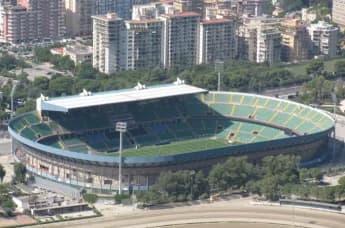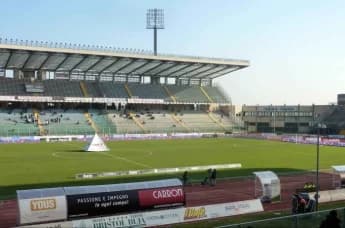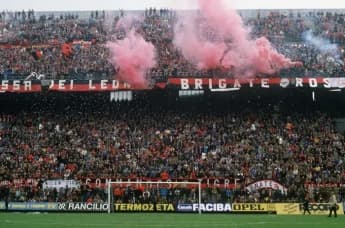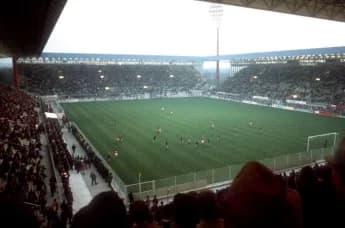The Stadio Olimpico stands as a symbol of Italy's vibrant sports culture, hosting thrilling games and cultural events that resonate with history and passionate fans from around the world.
The Stadio Olimpico is a monumental symbol of Italian sport, proudly situated within the Foro Italico sports complex in Rome, Italy. Positioned at the foot of Monte Mario in the lively Della Vittoria district, this legendary stadium reflects Italy's deep-rooted enthusiasm for football, athletics, and cultural festivities. Since its grand inauguration on May 17, 1953, featuring a match between Italy and Hungary, the stadium has evolved into one of the most esteemed venues in the world.
Originally built to accommodate an impressive 100,000 spectators, the Olimpico was designed to reflect the splendor of Italian architecture and the nation's increasing passion for sports. Throughout the years, the stadium has undergone several renovations, each improving its structure and amenities while maintaining its historical character. Today, with a seating capacity of 74,000, it remains a vital center for Italy’s sporting and cultural events.
The Stadio Olimpico serves as the home venue for two of Serie A's most prestigious teams, AS Roma and SS Lazio. Their intense rivalry generates some of the most thrilling atmospheres in global football. Additionally, the stadium frequently hosts the Italian national football team, further enhancing its esteemed legacy. In addition to football, the arena has played host to athletics competitions, performances by internationally acclaimed artists, and significant ceremonies that bring together fans and audiences from all around the world.
Throughout its history, the Stadio Olimpico has played a pivotal role in numerous significant events. It was a central venue during the 1960 Summer Olympics, where it hosted both the opening and closing ceremonies, in addition to various athletic competitions. The stadium also served as a key location for the 1990 FIFA World Cup, further cementing its legacy in sports history. Additionally, it has been the host for important European tournaments, such as the UEFA European Championships, several Champions League finals, and multiple Coppa Italia finals.
Nestled within the beautiful landscape of the Foro Italico complex, visitors to the Stadio Olimpico enjoy an experience that extends beyond just a game or event. The area is abundant with historical sites, lush greenery, and paths that provide stunning views of the cityscape. Its prime location guarantees easy access, offering a rich cultural experience that immerses guests in the lively atmosphere of Rome.
The Stadio Olimpico, recognized worldwide, transcends being merely a sports facility; it stands as a testament to resilience, tradition, and the profound passion a nation holds for both sports and culture. This iconic venue serves as a place of unity, where history, fervor, and contemporary existence intermingle, crafting unforgettable experiences for both athletes and supporters.
Memorable Matches
The Stadio Olimpico has served as the backdrop for countless memorable matches that have influenced the course of football history. One of the standout occasions was its inaugural match in 1953, a captivating clash between Italy and Hungary that showcased this legendary venue to the world. The stadium also gained significant prominence during the 1960 Olympics, where it became the centerpiece of international focus, hosting both the opening and closing ceremonies along with various athletic events, embodying the ideals of unity and sporting excellence.
In 1968, the stadium was the site of Italy's memorable victory in the European Championship final against Yugoslavia. After a closely contested first match that ended in a draw, Italy claimed a 2-0 win in the replay, celebrating the success of the home nation. Twelve years later, during Euro 1980, the Stadio Olimpico hosted three group matches and the final, where West Germany emerged victorious over Belgium with a score of 2-1, further solidifying its status as a top-tier football venue.
The stadium's magnificence was highlighted during the 1990 FIFA World Cup, where it hosted all of Italy's group stage matches and subsequent knockout rounds, culminating in the final between West Germany and Argentina. In a thrilling encounter, West Germany secured the championship with a close 1-0 win, a match forever remembered in football history. The Olimpico has also been the venue for numerous European Cup and Champions League finals, including Liverpool’s 1977 triumph over Borussia Mönchengladbach and the 1984 final, which saw a dramatic face-off between Liverpool and AS Roma that was settled by penalties.
In more recent years, the 1996 Champions League final witnessed Juventus triumph over Ajax in a gripping penalty shootout. Similarly, in 2009, Barcelona showcased an extraordinary performance, defeating Manchester United 2-0 and asserting their supremacy in European football. These notable matches not only emphasize the Stadio Olimpico’s capacity to host crucial encounters but also reinforce its reputation as a stage where dreams are realized and legends emerge.
Amenities & Services
The Stadio Olimpico is a symbol of architectural excellence and contemporary sports facilities. Originally built to hold up to 100,000 spectators, the stadium has undergone multiple significant renovations to uphold its status as one of the world's premier sporting venues. After its initial construction, substantial upgrades were made for the 1960 Olympics, transforming the large terraces into seating areas and decreasing its capacity to 53,000, which greatly enhanced the comfort and safety for attendees. Additional improvements leading up to the 1990 FIFA World Cup modernized the venue further; the pitch was moved closer to the audience to create a more engaging viewing atmosphere, and a cutting-edge roof was installed to better protect fans from weather conditions.
The stadium boasts top-notch facilities, featuring ample seating arrangements designed to provide unobstructed views from every seat, VIP lounges that deliver exceptional hospitality experiences, and state-of-the-art media and broadcasting suites for global coverage. Advanced lighting systems brilliantly illuminate the pitch for nighttime events, while sophisticated sound systems enhance the exhilarating atmosphere created by the crowd.
The Stadio Olimpico features a wide range of facilities aimed at improving the experience for fans. Attendees can savor a diverse selection of food and drink options available at conveniently located concession stands, which help minimize wait times during peak events. Additionally, the stadium is fully equipped for accessibility, providing accommodations for differently-abled attendees, including reserved seating, elevators, and accessible paths.
The area surrounding the stadium features ample parking options and an efficient transport network, ensuring that both local and international guests can easily access the venue. The Foro Italico sports complex enhances the stadium experience by providing additional amenities such as swimming pools, training facilities, and tennis courts, establishing it as a central hub for various sports and recreational activities.
In recent years, renovations have emphasized sustainability and technological advancements, featuring energy-efficient lighting and enhanced digital ticketing systems to facilitate entry procedures. These improvements ensure that the Stadio Olimpico not only preserves its historical allure but also keeps pace with the requirements of contemporary sporting events, providing a top-notch experience for both athletes and fans.
Significance in History
The Stadio Olimpico possesses a significant historical importance, serving not only as a representation of Italian sports culture but also as a site that has experienced key events in international football and athletics. Built during Italy's Fascist era as a component of the expansive Foro Italico sports complex, its inception reflects the intertwining of politics and sports in early 20th-century Europe. Originally known as the Stadio dei Cipressi, it emerged as a landmark for major gatherings and competitions, symbolizing the regime's aspiration for grandeur and unity through sport.
The stadium played a pivotal role during the 1960 Rome Olympics, symbolizing Italy's resurgence in the post-war era on the international stage. It hosted both the opening and closing ceremonies as well as the athletics competitions, providing a backdrop for legendary moments such as Wilma Rudolph's remarkable performances, which epitomized victory over challenges. This event marked a significant evolution for the Stadio Olimpico, elevating it from a local venue to a globally recognized sports arena.
The stadium's importance expanded as it became a central venue for significant football tournaments, including the UEFA European Championships in 1968 and 1980, the FIFA World Cup in 1990, and numerous European club finals. Notable matches, such as the Euro 1968 final, where Italy triumphed in a replay against Yugoslavia, and the 1990 World Cup final, where Germany emerged victorious over Argentina, further enhanced the stadium’s reputation within the history of football.
The Stadio Olimpico has remained a central fixture in Italian domestic football, acting as the joint home for both AS Roma and Lazio. It has witnessed numerous intense derby matches and memorable moments that characterize the heated rivalry between these two teams.
In addition to its sporting events, the Stadio Olimpico has been a venue for concerts, cultural activities, and ceremonies, establishing its reputation as a versatile space. Its ability to endure numerous renovations over the years highlights its flexibility and lasting significance. By adopting modern technological and structural improvements, the stadium has maintained its historical essence while continuing to function as a contemporary center for international events.
In the present day, the Stadio Olimpico is not merely a venue for sports; it symbolizes Italy's cultural and historical development, embodying the unity, fervor, and grandeur that characterize the country’s connection to sports.
Future Events
The Stadio Olimpico remains a central venue for exceptional sporting and entertainment events, upholding its status as one of the most renowned arenas in Europe. Looking ahead, it is scheduled to host several prominent football matches, including Serie A games featuring AS Roma and Lazio, two of Italy's most fervent football clubs. Additionally, the stadium plays a crucial role in the Coppa Italia, with its grand finale frequently taking place amid the illuminated atmosphere of the Olimpico, amplifying the excitement and significance of the tournament.
International football plays a vital role in the schedule of the Stadio Olimpico, as the venue frequently welcomes the matches of the Italian national team. With Italy gearing up for the upcoming UEFA European Championship qualifiers and international friendlies, fans can look forward to thrilling performances from the Azzurri as they strive for success. Furthermore, the stadium is under consideration for key matches in upcoming international tournaments, strengthening its position on the worldwide football scene.
In addition to football, the Olimpico remains a hotspot for significant cultural events, featuring international music performances by famous artists from around the world. The stadium's capacity, exceptional acoustics, and historic atmosphere make it an ideal venue for performers looking for a memorable stage in the Eternal City. Audiences can anticipate a variety of events that unite people from diverse backgrounds beneath the Roman sky.
The Stadio Olimpico continues to serve as a significant venue for the yearly Golden Gala, which is part of the Diamond League series. This prestigious event attracts top track and field athletes from around the globe, who compete before an enthusiastic audience, honoring the stadium's rich Olympic heritage.
As the Stadio Olimpico prepares for upgrades and modernization, it is set to improve the overall experience for fans while continuing to host a diverse array of events. Its capacity to merge tradition with contemporary elements guarantees its status as a focal point for sports and entertainment in Italy for many more years.
Experience for Fans
Experiencing an event at the Stadio Olimpico is a truly memorable affair, presenting a remarkable combination of history, enthusiasm, and contemporary facilities. Situated in the renowned Foro Italico region of Rome, the stadium offers spectators stunning views of Monte Mario and immerses them in a location rich with tradition. Whether attending a football game, a concert, or a significant athletic competition, the ambiance at Stadio Olimpico is charged with energy, driven by the passionate supporters of AS Roma and Lazio, alongside visiting fans from around the world.
The approach to the stadium creates an exciting atmosphere, offering easy access through public transport, plenty of parking spaces, and picturesque views of the sports complex. Upon entering, fans encounter roomy seating and a striking roof design that improves sound quality while providing excellent visibility of the field or stage from almost every position.
Throughout the venue, food and beverage stalls are thoughtfully positioned to provide a variety of traditional Italian snacks and beverages, as well as international choices. The hospitality services include VIP lounges and premium seating areas designed for those looking for a more luxurious experience. These areas offer exclusive dining, comfortable seating, and direct access to the event, ensuring an unforgettable visit.
The stadium is designed to be inclusive, featuring facilities that cater to disabled fans and families, thereby creating a friendly atmosphere for everyone. Advanced screens and sound systems enhance the live experience, ensuring that fans remain engaged and well-informed during the event. The recently upgraded seating offers comfort even during long events, and the lively crowd contributes to the overall ambiance, transforming any event into an unforgettable experience.
The passion for football in this region is unmatched, particularly during the Derby della Capitale, where AS Roma and SS Lazio compete against each other. The atmosphere is electrifying, filled with chants, banners, and tifos that create a stunning visual and auditory experience that lingers in the memory long after the game concludes. Additionally, concerts and cultural events take full advantage of the stadium's renowned backdrop, transforming them into unforgettable occasions.
As fans leave the stadium, they have the opportunity to explore the Foro Italico complex, which features scenic walking paths and notable landmarks that enrich the experience. The Stadio Olimpico offers more than simply a match or performance—it provides a deep cultural experience that connects visitors to the essence of Rome's rich sports and entertainment heritage.
The Stadio Olimpico is a monumental symbol of Italian sport, proudly situated within the Foro Italico sports complex in Rome, Italy. Positioned at the foot of Monte Mario in the lively Della Vittoria district, this legendary stadium reflects Italy's deep-rooted enthusiasm for football, athletics, and cultural festivities. Since its grand inauguration on May 17, 1953, featuring a match between Italy and Hungary, the stadium has evolved into one of the most esteemed venues in the world.
Originally built to accommodate an impressive 100,000 spectators, the Olimpico was designed to reflect the splendor of Italian architecture and the nation's increasing passion for sports. Throughout the years, the stadium has undergone several renovations, each improving its structure and amenities while maintaining its historical character. Today, with a seating capacity of 74,000, it remains a vital center for Italy’s sporting and cultural events.
The Stadio Olimpico serves as the home venue for two of Serie A's most prestigious teams, AS Roma and SS Lazio. Their intense rivalry generates some of the most thrilling atmospheres in global football. Additionally, the stadium frequently hosts the Italian national football team, further enhancing its esteemed legacy. In addition to football, the arena has played host to athletics competitions, performances by internationally acclaimed artists, and significant ceremonies that bring together fans and audiences from all around the world.
Throughout its history, the Stadio Olimpico has played a pivotal role in numerous significant events. It was a central venue during the 1960 Summer Olympics, where it hosted both the opening and closing ceremonies, in addition to various athletic competitions. The stadium also served as a key location for the 1990 FIFA World Cup, further cementing its legacy in sports history. Additionally, it has been the host for important European tournaments, such as the UEFA European Championships, several Champions League finals, and multiple Coppa Italia finals.
Nestled within the beautiful landscape of the Foro Italico complex, visitors to the Stadio Olimpico enjoy an experience that extends beyond just a game or event. The area is abundant with historical sites, lush greenery, and paths that provide stunning views of the cityscape. Its prime location guarantees easy access, offering a rich cultural experience that immerses guests in the lively atmosphere of Rome.
The Stadio Olimpico, recognized worldwide, transcends being merely a sports facility; it stands as a testament to resilience, tradition, and the profound passion a nation holds for both sports and culture. This iconic venue serves as a place of unity, where history, fervor, and contemporary existence intermingle, crafting unforgettable experiences for both athletes and supporters.
Memorable Matches
The Stadio Olimpico has served as the backdrop for countless memorable matches that have influenced the course of football history. One of the standout occasions was its inaugural match in 1953, a captivating clash between Italy and Hungary that showcased this legendary venue to the world. The stadium also gained significant prominence during the 1960 Olympics, where it became the centerpiece of international focus, hosting both the opening and closing ceremonies along with various athletic events, embodying the ideals of unity and sporting excellence.
In 1968, the stadium was the site of Italy's memorable victory in the European Championship final against Yugoslavia. After a closely contested first match that ended in a draw, Italy claimed a 2-0 win in the replay, celebrating the success of the home nation. Twelve years later, during Euro 1980, the Stadio Olimpico hosted three group matches and the final, where West Germany emerged victorious over Belgium with a score of 2-1, further solidifying its status as a top-tier football venue.
The stadium's magnificence was highlighted during the 1990 FIFA World Cup, where it hosted all of Italy's group stage matches and subsequent knockout rounds, culminating in the final between West Germany and Argentina. In a thrilling encounter, West Germany secured the championship with a close 1-0 win, a match forever remembered in football history. The Olimpico has also been the venue for numerous European Cup and Champions League finals, including Liverpool’s 1977 triumph over Borussia Mönchengladbach and the 1984 final, which saw a dramatic face-off between Liverpool and AS Roma that was settled by penalties.
In more recent years, the 1996 Champions League final witnessed Juventus triumph over Ajax in a gripping penalty shootout. Similarly, in 2009, Barcelona showcased an extraordinary performance, defeating Manchester United 2-0 and asserting their supremacy in European football. These notable matches not only emphasize the Stadio Olimpico’s capacity to host crucial encounters but also reinforce its reputation as a stage where dreams are realized and legends emerge.
Amenities & Services
The Stadio Olimpico is a symbol of architectural excellence and contemporary sports facilities. Originally built to hold up to 100,000 spectators, the stadium has undergone multiple significant renovations to uphold its status as one of the world's premier sporting venues. After its initial construction, substantial upgrades were made for the 1960 Olympics, transforming the large terraces into seating areas and decreasing its capacity to 53,000, which greatly enhanced the comfort and safety for attendees. Additional improvements leading up to the 1990 FIFA World Cup modernized the venue further; the pitch was moved closer to the audience to create a more engaging viewing atmosphere, and a cutting-edge roof was installed to better protect fans from weather conditions.
The stadium boasts top-notch facilities, featuring ample seating arrangements designed to provide unobstructed views from every seat, VIP lounges that deliver exceptional hospitality experiences, and state-of-the-art media and broadcasting suites for global coverage. Advanced lighting systems brilliantly illuminate the pitch for nighttime events, while sophisticated sound systems enhance the exhilarating atmosphere created by the crowd.
The Stadio Olimpico features a wide range of facilities aimed at improving the experience for fans. Attendees can savor a diverse selection of food and drink options available at conveniently located concession stands, which help minimize wait times during peak events. Additionally, the stadium is fully equipped for accessibility, providing accommodations for differently-abled attendees, including reserved seating, elevators, and accessible paths.
The area surrounding the stadium features ample parking options and an efficient transport network, ensuring that both local and international guests can easily access the venue. The Foro Italico sports complex enhances the stadium experience by providing additional amenities such as swimming pools, training facilities, and tennis courts, establishing it as a central hub for various sports and recreational activities.
In recent years, renovations have emphasized sustainability and technological advancements, featuring energy-efficient lighting and enhanced digital ticketing systems to facilitate entry procedures. These improvements ensure that the Stadio Olimpico not only preserves its historical allure but also keeps pace with the requirements of contemporary sporting events, providing a top-notch experience for both athletes and fans.
Significance in History
The Stadio Olimpico possesses a significant historical importance, serving not only as a representation of Italian sports culture but also as a site that has experienced key events in international football and athletics. Built during Italy's Fascist era as a component of the expansive Foro Italico sports complex, its inception reflects the intertwining of politics and sports in early 20th-century Europe. Originally known as the Stadio dei Cipressi, it emerged as a landmark for major gatherings and competitions, symbolizing the regime's aspiration for grandeur and unity through sport.
The stadium played a pivotal role during the 1960 Rome Olympics, symbolizing Italy's resurgence in the post-war era on the international stage. It hosted both the opening and closing ceremonies as well as the athletics competitions, providing a backdrop for legendary moments such as Wilma Rudolph's remarkable performances, which epitomized victory over challenges. This event marked a significant evolution for the Stadio Olimpico, elevating it from a local venue to a globally recognized sports arena.
The stadium's importance expanded as it became a central venue for significant football tournaments, including the UEFA European Championships in 1968 and 1980, the FIFA World Cup in 1990, and numerous European club finals. Notable matches, such as the Euro 1968 final, where Italy triumphed in a replay against Yugoslavia, and the 1990 World Cup final, where Germany emerged victorious over Argentina, further enhanced the stadium’s reputation within the history of football.
The Stadio Olimpico has remained a central fixture in Italian domestic football, acting as the joint home for both AS Roma and Lazio. It has witnessed numerous intense derby matches and memorable moments that characterize the heated rivalry between these two teams.
In addition to its sporting events, the Stadio Olimpico has been a venue for concerts, cultural activities, and ceremonies, establishing its reputation as a versatile space. Its ability to endure numerous renovations over the years highlights its flexibility and lasting significance. By adopting modern technological and structural improvements, the stadium has maintained its historical essence while continuing to function as a contemporary center for international events.
In the present day, the Stadio Olimpico is not merely a venue for sports; it symbolizes Italy's cultural and historical development, embodying the unity, fervor, and grandeur that characterize the country’s connection to sports.
Future Events
The Stadio Olimpico remains a central venue for exceptional sporting and entertainment events, upholding its status as one of the most renowned arenas in Europe. Looking ahead, it is scheduled to host several prominent football matches, including Serie A games featuring AS Roma and Lazio, two of Italy's most fervent football clubs. Additionally, the stadium plays a crucial role in the Coppa Italia, with its grand finale frequently taking place amid the illuminated atmosphere of the Olimpico, amplifying the excitement and significance of the tournament.
International football plays a vital role in the schedule of the Stadio Olimpico, as the venue frequently welcomes the matches of the Italian national team. With Italy gearing up for the upcoming UEFA European Championship qualifiers and international friendlies, fans can look forward to thrilling performances from the Azzurri as they strive for success. Furthermore, the stadium is under consideration for key matches in upcoming international tournaments, strengthening its position on the worldwide football scene.
In addition to football, the Olimpico remains a hotspot for significant cultural events, featuring international music performances by famous artists from around the world. The stadium's capacity, exceptional acoustics, and historic atmosphere make it an ideal venue for performers looking for a memorable stage in the Eternal City. Audiences can anticipate a variety of events that unite people from diverse backgrounds beneath the Roman sky.
The Stadio Olimpico continues to serve as a significant venue for the yearly Golden Gala, which is part of the Diamond League series. This prestigious event attracts top track and field athletes from around the globe, who compete before an enthusiastic audience, honoring the stadium's rich Olympic heritage.
As the Stadio Olimpico prepares for upgrades and modernization, it is set to improve the overall experience for fans while continuing to host a diverse array of events. Its capacity to merge tradition with contemporary elements guarantees its status as a focal point for sports and entertainment in Italy for many more years.
Experience for Fans
Experiencing an event at the Stadio Olimpico is a truly memorable affair, presenting a remarkable combination of history, enthusiasm, and contemporary facilities. Situated in the renowned Foro Italico region of Rome, the stadium offers spectators stunning views of Monte Mario and immerses them in a location rich with tradition. Whether attending a football game, a concert, or a significant athletic competition, the ambiance at Stadio Olimpico is charged with energy, driven by the passionate supporters of AS Roma and Lazio, alongside visiting fans from around the world.
The approach to the stadium creates an exciting atmosphere, offering easy access through public transport, plenty of parking spaces, and picturesque views of the sports complex. Upon entering, fans encounter roomy seating and a striking roof design that improves sound quality while providing excellent visibility of the field or stage from almost every position.
Throughout the venue, food and beverage stalls are thoughtfully positioned to provide a variety of traditional Italian snacks and beverages, as well as international choices. The hospitality services include VIP lounges and premium seating areas designed for those looking for a more luxurious experience. These areas offer exclusive dining, comfortable seating, and direct access to the event, ensuring an unforgettable visit.
The stadium is designed to be inclusive, featuring facilities that cater to disabled fans and families, thereby creating a friendly atmosphere for everyone. Advanced screens and sound systems enhance the live experience, ensuring that fans remain engaged and well-informed during the event. The recently upgraded seating offers comfort even during long events, and the lively crowd contributes to the overall ambiance, transforming any event into an unforgettable experience.
The passion for football in this region is unmatched, particularly during the Derby della Capitale, where AS Roma and SS Lazio compete against each other. The atmosphere is electrifying, filled with chants, banners, and tifos that create a stunning visual and auditory experience that lingers in the memory long after the game concludes. Additionally, concerts and cultural events take full advantage of the stadium's renowned backdrop, transforming them into unforgettable occasions.
As fans leave the stadium, they have the opportunity to explore the Foro Italico complex, which features scenic walking paths and notable landmarks that enrich the experience. The Stadio Olimpico offers more than simply a match or performance—it provides a deep cultural experience that connects visitors to the essence of Rome's rich sports and entertainment heritage.







